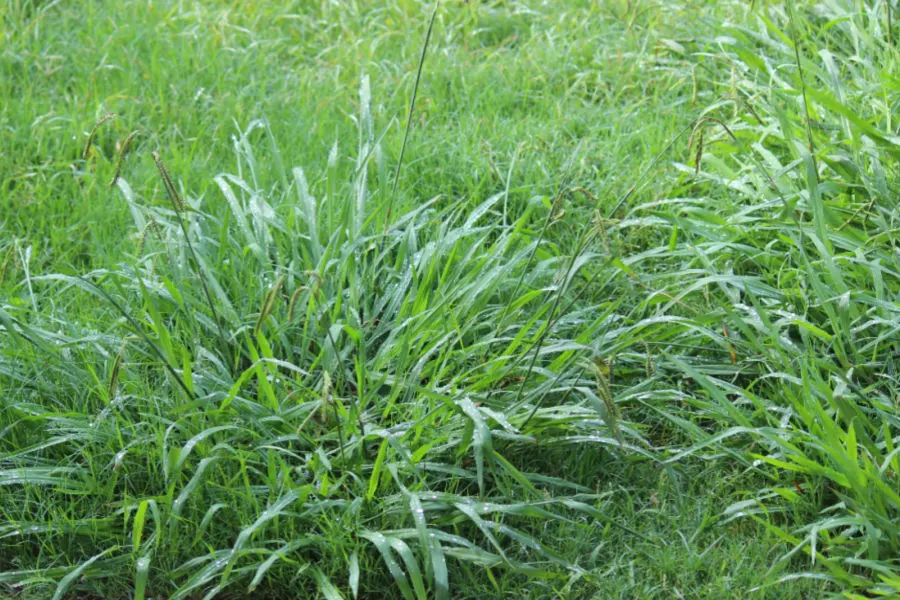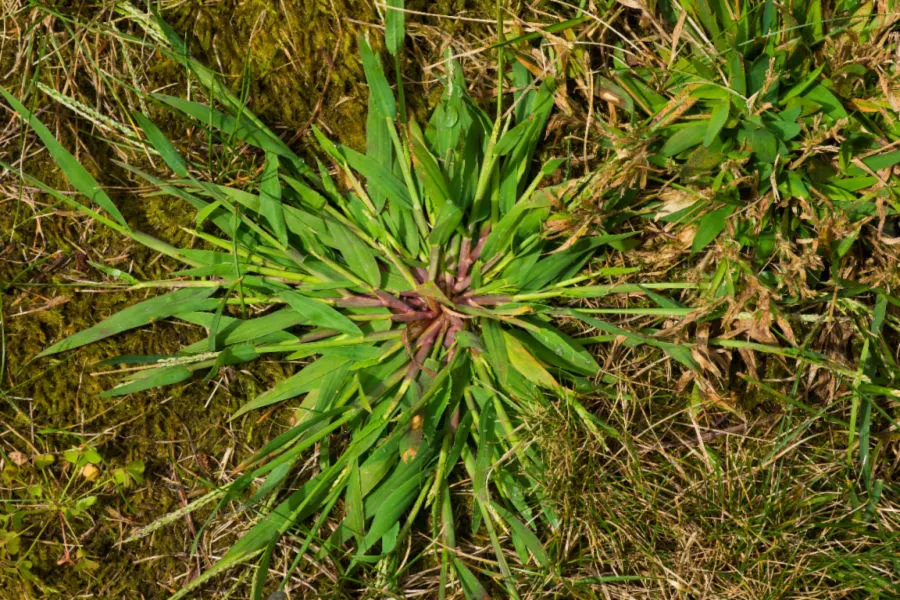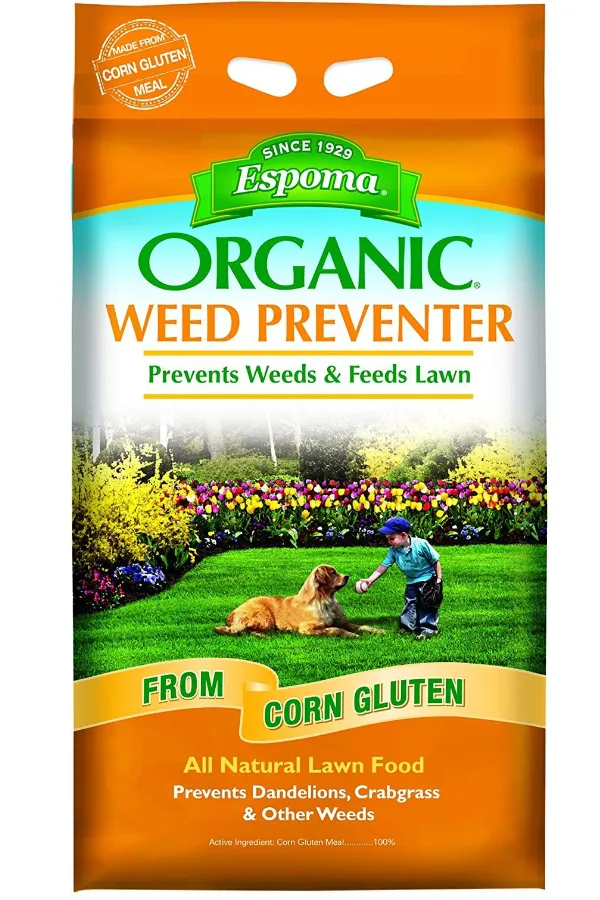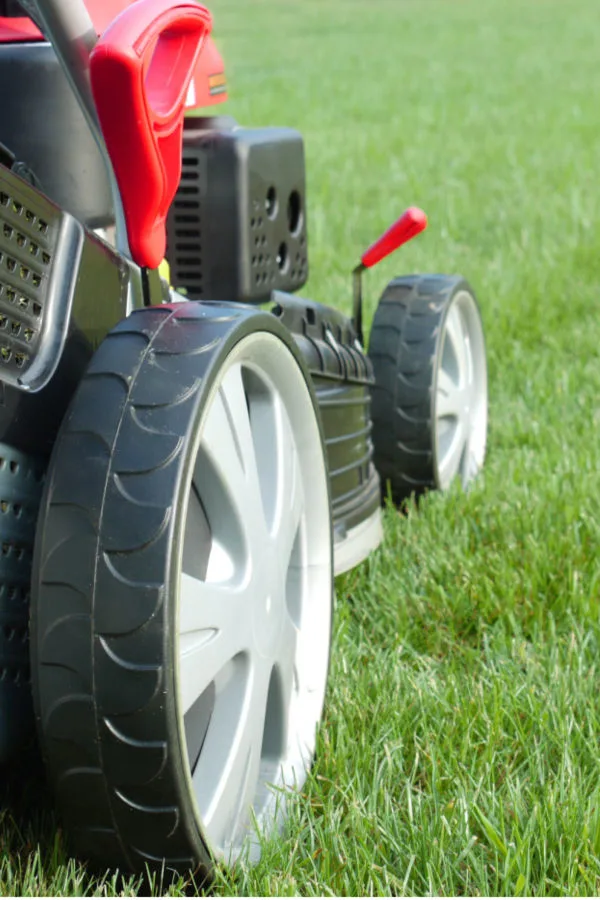There is no better time than early spring to prevent crabgrass in your lawn – and best of all – you can stop it naturally with a 100% organic approach!
If you are tired of helplessly watching crabgrass overtake your lawn every summer and fall, then early in the year is the time to finally take charge of your yard. Unfortunately, spring is the only time you can really prevent new seeds from germinating. And if you miss your chance, the problem only multiplies.
Crabgrass can be a nightmare for those who like to keep their lawn neat and tidy. The fast growing weed branches out quickly from its main stem. As it does, new roots form from nodes on the sprawling branches.

Before your know it, a single sprout becomes a large mass of yellowy-green grass. And can it ever stick out like a sore thumb! Especially against the darker green blades of the natural green grass growing in your lawn.
With over 30 varieties of invasive crabgrass that grow in all types of climates, the weed can pop up anywhere. When you add in that once established, mature plants can produce thousands of seeds, it’s easy to see why it can be so hard to eliminate.
The good news is that you can gain the upper hand on crabgrass. And best of all, you don’t have to resort to harsh chemicals or sprays to do it. But to have success, the biggest key of all is to start attacking the issue in early spring, before crabgrass has a chance to sprout!
How To Prevent Crabgrass In The Spring
Why is early spring so critical in the fight against crabgrass? Because if you can treat the seeds before they sprout, crabgrass has no chance of survival. It won’t be able to sprout. Nor can it grow and produce even more seeds to spread around your lawn.
As you will see below, there are several additional steps you can take throughout spring, summer and fall that can help to eliminate crabgrass from your lawn – but success all starts with putting down an organic pre-emergent in early spring to keep the stubborn weed from germinating.
Using An Organic Pre-Emergent Treatment To Prevent Crabgrass
The best way to keep crabgrass seeds from germinating is by using a pre-emergent. A pre-emergent is a fancy word for a substance that stops a seed from being able to sprout. By sterilizing the seed on contact, it then becomes unable to germinate.

Although there is a long list of synthetic pre-emergents on the market, they can be a bit scary when it comes to using around children, pets and even adults. We like to keep our farm 100% organic. And luckily, when it comes to pre-emergent crabgrass control, there is a wonderful all-natural solution.
Believe it or not, corn gluten is a great organic alternative as a pre-emergent control for crabgrass. Even better, it also happens to prevent many other common weeds from germinating as well.
As if that wasn’t enough, corn gluten contains around 10% nitrogen. That means not only can it work as a pre-emergent, but it can also provide power to your lawn. It is a win-win for sure, but again, the key is getting the pre-emergent down before the seeds sprout!
Applying A Pre-Emergent Early – How To Prevent Crabgrass In The Spring
The word “pre-emergent” tells the story when it comes to using any crabgrass stopping product. In order for the corn gluten to work, it MUST be put down before (pre) the crabgrass begins to emerge and grow.

Once crabgrass (or any weed for that matter) germinates, a pre-emergent will not work. It is not an herbicide, but instead a way to prevent the crabgrass from starting to grow. Because of that, you need to get the product down early, before your grass ever starts to even begin to green up.
For us here in Ohio, that means the first part of March. To apply, you can use a drop or broadcast spreader. We always prefer broadcast spreaders as they more evenly coat the grass. Always check the product bag for recommended rates.
For large yards, you can often find bulk corn gluten as well as an economical choice. We use the Espoma brand and apply about 20 lbs. per 1,000 sq. ft. Affiliate Product Link: Espoma Organic Weed Preventer
Before applying, it’s actually a great idea to first mow your lawn to get it to a lower, more even height. This will allow the product to find it’s way to coat the entire surface of the lawn. The product sticks better when the grass is slightly wet, so applying in the early morning dew is great. You can also lightly water it in if your lawn is small enough to do so.
Here is the best part of using an organic product, it is safe for pets or children immediately. With that said, we always try to limit walking traffic for a few days just to get the product to stick better and not disturb it.
Effectiveness Of Pre-Emergents – How To Prevent Crabgrass In The Spring
Like any application, how effective a pre-emergent will be can vary on when it is put down and the overall coverage. It is quite impressive just how much it can prevent with a first application, but it can take a few years to really knock it out. Again, like with any gardening task, consistency is the ultimate key to success.

Additional Ways To Stop Crabgrass
There are other important factors in how crabgrass grows and spreads that you can help control throughout the growing season. First and foremost, how you mow your lawn can play a big role in keeping crabgrass at bay, or in helping it to spread.
Mowing your lawn high is one of the best things you can do for your turf’s overall health. It helps keep valuable moisture in the soil and keeps weed seeds (like crabgrass) from finding a home.
In addition, a higher lawn creates a thicker lawn, which blocks sunlight from the soil. That is extremely critical in helping to stop crabgrass as it needs sunlight to germinate. For best results, try to keep your lawn height between 3 to 3.5 inches throughout the growing season.
Hand Picking Crabgrass In The Summer – How To Prevent Crabgrass In The Spring
Finally, one of the best ways to really get the upper hand on crabgrass is to hand pick any large plants that remain. Especially before they can produce their seed heads which can spread it fast.

Crabgrass is quite easy to spot in the summer and early fall months. It also is fairly easy to remove with a small weeding fork or shovel. Once you pull the plants, it’s a great idea to throw down a bit of grass seed to help fill in the bare spot.
Here’s to preventing an onslaught of crabgrass this spring, and to stopping crabgrass from taking over your lawn this summer and fall! For more on lawn care, check out our article : How To Stripe A Lawn Like A Pro – The Simple Secrets For Perfect Stripes!
Happy Gardening- Jim and Mary.
Jim and Mary Competti have been writing gardening, DIY and recipe articles and books for over 15 years from their 46 acre Ohio farm. The two are frequent speakers on all things gardening and love to travel in their spare time.
As always, feel free to email us at thefarm@owgarden.com with comments, questions, or to simply say hello! You can sign up for our free email list in the subscribe now box in the middle of this article. Follow us on Facebook here : OWG Facebook. This article may contain affiliate links.
